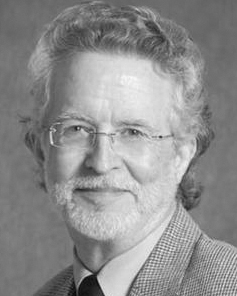|
Where There's the Most Light: Motivation and Behavior Analysis [Donde hay más luz: motivación y análisis de conducta] |
| Friday, November 25, 2011 |
| 10:00 AM–10:50 AM |
| Sala Manuel de Falla/Manual de Falla Hall |
| Area: TPC; Domain: Theory |
| CE Instructor: M. Jackson Marr, Ph.D. |
| Chair: Linda J. Parrott Hayes (University of Nevada, Reno) |
| M. JACKSON MARR (Georgia Institute of Technology) |
 M. Jackson (Jack) Marr is professor emeritus of psychology at Georgia Tech where he has taught physiology and behavior, behavioral pharmacology, probability & statistics, and continues to teach the experimental analysis of behavior. He is one of five founding fellows of the Association for Behavior Analysis International, a fellow of Division 25 (Behavior Analysis) of the American Psychological Association (APA), past-president of the Society for the Advancement of Behavior Analysis, past-president of both the Association for Behavior Analysis and Division 25 of APA. He is the former editor of Behavior and Philosophy and has served as review editor of the Journal of the Experimental Analysis of Behavior since 1998. He was an associate editor of the Journal of the Experimental Analysis of Behavior and The Behavior Analyst. He was experimental representative to the Executive Council of the Association for Behavior Analysis, served on the Board of Directors of The Society for the Quantitative Analysis of Behavior (SQAB), and currently serves on the Board of Trustees the Cambridge Center for Behavioral Studies. He has been active in the international support and development of behavior analysis in many countries. Since 1991 he has been involved in the assessment and improvement of engineering education, in particular, engineering physics. Other current research interests include dynamical systems theory, comparative behavior analysis, and theoretical/conceptual issues in behavioral analysis. Información biográfica (en español) M. Jackson (Jack) Marr is professor emeritus of psychology at Georgia Tech where he has taught physiology and behavior, behavioral pharmacology, probability & statistics, and continues to teach the experimental analysis of behavior. He is one of five founding fellows of the Association for Behavior Analysis International, a fellow of Division 25 (Behavior Analysis) of the American Psychological Association (APA), past-president of the Society for the Advancement of Behavior Analysis, past-president of both the Association for Behavior Analysis and Division 25 of APA. He is the former editor of Behavior and Philosophy and has served as review editor of the Journal of the Experimental Analysis of Behavior since 1998. He was an associate editor of the Journal of the Experimental Analysis of Behavior and The Behavior Analyst. He was experimental representative to the Executive Council of the Association for Behavior Analysis, served on the Board of Directors of The Society for the Quantitative Analysis of Behavior (SQAB), and currently serves on the Board of Trustees the Cambridge Center for Behavioral Studies. He has been active in the international support and development of behavior analysis in many countries. Since 1991 he has been involved in the assessment and improvement of engineering education, in particular, engineering physics. Other current research interests include dynamical systems theory, comparative behavior analysis, and theoretical/conceptual issues in behavioral analysis. Información biográfica (en español) |
| Abstract: "Motivation" is a topic many behavior analysts have mixed feelings about, despite all the literature on "establishing" or "motivational" operations. I argue that behavior analysts, particularly in their common treatment of reinforcement, are guilty of limited vision and in many ways still tied to traditional motivational concepts—where the light is better. This is illustrated by recent discussion of putative distinctions (or none) between positive and negative reinforcement as well as naive perspectives on so-called conditioned reinforcement. Most behavior, in fact, is controlled by consequences having little, if any, relation to motivational variables. In this treatment, I provide a definition of motivation and discuss some of the common variables said to control probabilities of action. I then discuss the strange implications of the positive vs. negative reinforcement controversy and the role of the history of contingencies in controlling the effects of consequences. Finally I review the place of feedback functions in the analysis of behavior. Behavior analysis needs to search beyond its current horizons where there may be even more light—certainly more enlightenment. [Resumen: La "motivación" es un tema sobre el que muchos analistas del comportamiento tienen sentimientos encontrados, a pesar de toda la literatura sobre operaciones "de establecimiento" o "motivacionales". Yo sostengo que los analistas del comportamiento, sobre todo en su tratamiento habitual del tema del refuerzo, han pecado de adoptar una visión limitada y en muchos aspectos todavía ligada a la concepción tradicional de la motivación, aplicando el viejo aforismo de aprovechar “donde la luz es mejor”. Esto es ilustrado por la reciente discusión sobre las supuestas diferencias entre refuerzo positivo y negativo, así como por perspectivas ingenuas sobre el denominado refuerzo condicionado. La mayoría de comportamiento, de hecho, está controlado consecuencias que tienen poca, o ninguna, relación con variables motivacionales. En esta presentación proporciono una definición de la motivación y discuto algunas de las variables que frecuentemente se afirma que controlan las probabilidades de acción. Entonces discuto las extrañas implicaciones de la controversia acerca de refuerzo positivo frente a negativo y el papel de la historia de contingencias en el control de los efectos de las consecuencias. Por último, reviso el papel de las funciones de retroalimentación en el análisis del comportamiento. El análisis del comportamiento tiene que buscar más allá de sus horizontes actuales, en los que puede haber aún más luz—sin duda más “iluminación”.] |
|
| |
| |
|
Behavioral Systems Science for Nonviolent Struggle [Ciencia de sistemas conductuales a favor de la no violencia] |
| Friday, November 25, 2011 |
| 11:00 AM–11:50 AM |
| Sala Manuel de Falla/Manual de Falla Hall |
| Area: TPC; Domain: Applied Behavior Analysis |
| CE Instructor: Mark A. Mattaini, Ph.D. |
| Chair: Karola Dillenburger (Queens University of Belfast) |
| MARK A. MATTAINI (Jane Addams College of Social Work, University of Illinois at Chicago) |
 Mark Mattaini, DSW (Columbia, 1990), is associate professor, Jane Addams College of Social Work, University of Illinois at Chicago, where he has led the development of the new community health and urban development concentration. Editor of the scientific journal Behavior and Social Issues, Dr. Mattaini is also the author/editor of 10 books, including PEACE POWER for Adolescents: Strategies for a Culture of Nonviolence (NASW Press), and Finding Solutions to Social Problems: Behavioral Strategies for Change (American Psychological Association), and over 80 other publications. Since the mid-90s, Dr. Mattaini has focused his research and practice on behavioral systems science for violence prevention with youth, constructing cultures of respect in organizations and communities, and effective nonviolent social action. He is the principal developer of the behavior analytic PEACE POWER strategy, which has been presented and implemented in at least 12 states, 2 Canadian provinces, and was recently introduced in a United Nations Educational, Scientific and Cultural Organization (UNESCO)-funded project in Brazil. He also recently provided consultation to the National Police and community organizations working to develop more effective ways to work with criminal youth gangs in Medellin, Colombia. He is currently completing a book, tentatively entitled Strategic Nonviolent Power: The Science of Satyagraha, analyzing the potential contributions of the science of behavior to nonviolent social action supporting justice and human rights. Información biográfica (en español) Mark Mattaini, DSW (Columbia, 1990), is associate professor, Jane Addams College of Social Work, University of Illinois at Chicago, where he has led the development of the new community health and urban development concentration. Editor of the scientific journal Behavior and Social Issues, Dr. Mattaini is also the author/editor of 10 books, including PEACE POWER for Adolescents: Strategies for a Culture of Nonviolence (NASW Press), and Finding Solutions to Social Problems: Behavioral Strategies for Change (American Psychological Association), and over 80 other publications. Since the mid-90s, Dr. Mattaini has focused his research and practice on behavioral systems science for violence prevention with youth, constructing cultures of respect in organizations and communities, and effective nonviolent social action. He is the principal developer of the behavior analytic PEACE POWER strategy, which has been presented and implemented in at least 12 states, 2 Canadian provinces, and was recently introduced in a United Nations Educational, Scientific and Cultural Organization (UNESCO)-funded project in Brazil. He also recently provided consultation to the National Police and community organizations working to develop more effective ways to work with criminal youth gangs in Medellin, Colombia. He is currently completing a book, tentatively entitled Strategic Nonviolent Power: The Science of Satyagraha, analyzing the potential contributions of the science of behavior to nonviolent social action supporting justice and human rights. Información biográfica (en español) |
| Abstract: Mohandas Gandhi often indicated that nonviolence was "a science," and he apparently meant this literally, but very little actual scientific work—almost none from a natural science perspective—has been done. In this paper, the author will outline and apply principles of behavioral systems science, an emerging data-based approach to understanding the dynamics of complex cultural systems, to the practice of effective nonviolent struggle. Behavioral systems science, which at its most sophisticated integrates autopoietic processes of internal self-organization with environmental selection, has the potential to contribute to social justice, human rights, and sustainability in ways that more mechanistic (allopoietic) cultural analytic approaches do not. It is widely accepted that strategic analysis and planning can optimize campaigns of nonviolent action and resistance, while lack of such analysis increases risks of failure and casualties. This presentation will analyze four major classes of strategic nonviolent action from a functional perspective, identifying the basic behavioral and behavioral systems dynamics involved with each, illustrating those dynamics with historical and contemporary cases. The four major classes explored here, in part adapted from work by Gene Sharp, are:(a) Constructive noncooperation; (b) Protest and persuasion;(c) Resistant noncooperation;(d) Nonviolent disruption Such analyses offer real advances to existing, largely ad hoc, understandings of effective nonviolent struggle, clarifying conditions supporting success as well as potential costs. Principles of behavioral systems science offer direction for real world experimentation, clearly an essential next step (although a challenging one to initiate). This presentation will also highlight important ethical questions that must be considered in bringing behavioral systems science to nonviolent struggle. Given the enormous human costs of violent strategies of resistance, insurgency and rebellion, and their poor record of sustainable success, the rigorous exploration of alternatives is a critically important direction for applied cultural analysis. [Resumen: Mohandas Gandhi indicó a menudo que la no violencia era una "ciencia", y al parecer afirmaba esto de forma literal. No obstante, se ha realizado muy poco trabajo científico en este ámbito; casi ninguno desde una perspectiva de la ciencia natural. En este trabajo, el autor expondrá y aplicará los principios de la ciencia de los sistemas conductuales, un enfoque emergente basado en datos dirigido a entender la dinámica de los sistemas culturales complejos, a la práctica de la lucha no violenta eficaz. La ciencia de los sistemas conductuales, que en su versión más sofisticada integra procesos autopoiéticos de auto-organización interna con la selección del medio ambiente, tiene el potencial de contribuir a la justicia social, a los derechos humanos y a la sostenibilidad de una forma que no lo hacen los enfoques analítico culturales más mecanicistas (alopoiético). Es ampliamente aceptado que el análisis estratégico y la planificación pueden optimizar las campañas de acción no violenta y resistencia, mientras que la falta de un análisis de este tipo incrementa los riesgos de fracaso y de víctimas. En esta presentación se analizan cuatro clases principales de acción estratégica no violenta desde una perspectiva funcional, identificando los sistemas dinámicos conductuales y los sistemas básicos de conducta implicados en cada uno, ilustrando dichas dinámicas con casos históricos y contemporáneos. Las cuatro clases principales estudiadas aquí, adaptadas en parte del trabajo de Gene Sharp, son los siguientes: (a) la falta de cooperación constructiva, (b) la protesta y la persuasión, (c) la falta de cooperación resistente, y (d) la interrupción no violenta. Tales análisis ofrecen avances reales respecto a las explicaciones existentes, en gran medida ad hoc, de la lucha no violenta eficaz, clarificando las condiciones que favorecen el éxito, así como los costes potenciales. Los principios de la ciencia de los sistemas conductuales ofrecen indicaciones para la experimentación en el mundo real, claramente un paso esencial (aunque un reto para sus pioneros). Esta presentación también pondrá de relieve importantes cuestiones éticas que deben ser consideradas en la aplicación de la ciencia de los sistemas conductuales a la lucha no violenta. Dados los enormes costos humanos de las estrategias violentas de resistencia, insurgencia y rebelión y su pobre historial de éxito duradero, la intensa exploración de alternativas es un área muy importante para el análisis cultural aplicado.] |
|
| |
| |
|
Choice, Impulsive Behavior, and Dopamine (D2) Receptors [Elección, conducta impulsiva y receptores dopaminérgicos D2] |
| Friday, November 25, 2011 |
| 12:00 PM–12:50 PM |
| Sala Manuel de Falla/Manual de Falla Hall |
| Area: EAB; Domain: Experimental Analysis |
| CE Instructor: Carlos F. Aparicio, Ph.D. |
| Chair: Maria Helena Hunziker (University of São Paulo) |
| CARLOS F. APARICIO (Savannah State University) |
 Dr. Carlos F. Aparicio received his B.A. (1979) and M.A. (1983) in experimental analysis of behavior from the National Autonomous University of Mexico (UNAM). In 1988, he joined the graduate program in psychology at the University of New Hampshire where he received his Ph.D. in 1992, working under the supervision of Drs. William M. Baum and Anthony Nevin. Dr. Aparicio established a research program studying the role of physical effort and locomotion in choice behavior. He created an original method, "The Barrier Choice Paradigm," to manipulate travel distance among several alternatives concurrently available in the choice situation. This method has been successfully used to assess the effects of neuroleptic drugs in motor and motivational aspects of behavior, making an important contribution to our understanding of the behavioral functions of brain dopamine. He uses behavioral methods, mathematical models, and empirical parameters to assess the effects of dopamine antagonism. Recently, he developed a novel procedure to study impulsiveness and self-control, comparing and contrasting preferences of subjects with dopamine and serotonin deficiencies with preferences of subjects without deficiencies in these neurotransmitters. Dr. Aparicio's interests in applied behavior analysis and some of his contributions can be found in http://autismoaba.org/. Información biográfica (en español) Dr. Carlos F. Aparicio received his B.A. (1979) and M.A. (1983) in experimental analysis of behavior from the National Autonomous University of Mexico (UNAM). In 1988, he joined the graduate program in psychology at the University of New Hampshire where he received his Ph.D. in 1992, working under the supervision of Drs. William M. Baum and Anthony Nevin. Dr. Aparicio established a research program studying the role of physical effort and locomotion in choice behavior. He created an original method, "The Barrier Choice Paradigm," to manipulate travel distance among several alternatives concurrently available in the choice situation. This method has been successfully used to assess the effects of neuroleptic drugs in motor and motivational aspects of behavior, making an important contribution to our understanding of the behavioral functions of brain dopamine. He uses behavioral methods, mathematical models, and empirical parameters to assess the effects of dopamine antagonism. Recently, he developed a novel procedure to study impulsiveness and self-control, comparing and contrasting preferences of subjects with dopamine and serotonin deficiencies with preferences of subjects without deficiencies in these neurotransmitters. Dr. Aparicio's interests in applied behavior analysis and some of his contributions can be found in http://autismoaba.org/. Información biográfica (en español) |
| Abstract: The neurotransmitter dopamine (DA) is involved in motor and motivational aspects of behavior. Dopamine is also linked to motivation for stimuli causing pleasure, impulsiveness, and attention deficit and hyperactivity disorders (ADHD), leading some theorists to suggest that DA acts as a reward system mediating the hedonic effects of pleasant stimuli. The identification of factors maintaining drug addictions and those impairing motor functions will contribute to developing new treatment strategies and therapeutic practices. Research programs aimed to explore these ideas in systematic ways are needed. In the laboratory choice situations are prepared to assess self-control, an important aspect involved in substance abuse. This talk presents the findings obtained with a novel procedure designed to study impulsive behavior and self-control. Subjects faced a choice between two response alternatives, one providing a small-sooner (SS) amount of food contingent upon responding, and the other delivering a larger-later (LL) amount of food after a delay that increased in a systematic way (0, 5, 10, 20, 40 or 80 s) within sessions. While impulsive subjects preferred the former alternative, the self-controlled subjects preferred the latter alternative. Baselines of impulsive and self-controlled choice were used to assess the effects of drugs targeting DA receptors (D2) on the choices of subjects with DA deficiencies and subjects without DA deficiencies. The implication of present findings to develop models of ADHD and substance abuse will be discussed. [Resumen: El neurotransmisor dopamina (DA) está involucrado en los aspectos motores y motivacionales de la conducta. La dopamina también está vinculada a la motivación hacia los estímulos que causan placer, en la impulsividad y en los desórdenes de déficit de atención e hiperactividad (TDAH), lo que ha llevado a algunos teóricos a sugerir que la DA actúa como un sistema de recompensa mediando los efectos hedónicos de estímulos agradables. La identificación de los factores de mantenimiento de las drogodependencias y de aquellos implicados en las funciones motoras dañadas contribuirá al desarrollo de nuevas estrategias de tratamiento y prácticas terapéuticas. Son necesarios programas de investigación destinados a explorar estas ideas de forma sistemática. En el laboratorio las situaciones de elección están preparadas para evaluar el auto-control, un aspecto importante involucrado en el abuso de drogas. Esta conferencia presenta los resultados obtenidos con un nuevo procedimiento diseñado para estudiar el comportamiento impulsivo y el auto-control. Se enfrentó a los sujetos a una elección entre dos alternativas de respuesta, una proporcionaba una pequeña cantidad de alimento inmediata tras la respuesta, y otra en la que se entregaba una cantidad mayor de alimento pero demorada, cuyo retraso se incrementó de manera sistemática (0 , 5, 10, 20, 40 o 80 segundos) a lo largo de las sesiones. Mientras que los sujetos impulsivos prefieren la primera alternativa, los sujetos con auto-control prefieren la segunda alternativa. Se utilizaron las líneas de base de la elección impulsiva y con autocontrol para evaluar los efectos de fármacos dirigidos a los receptores de DA (D2) en las elecciones de los sujetos con deficiencias DA y sujetos sin deficiencias DA. Se discutirá la implicación de los resultados obtenidos para desarrollar modelos de TDAH y de abuso de drogas.] |
|
| |
| |
|
Stimulus Equivalence Via Simple Discrimination Training: A Translational Approach [Establecimiento de control de estímulo mediante entrenamiento en discriminación simple: Un abordaje translacional] |
| Friday, November 25, 2011 |
| 1:00 PM–1:50 PM |
| Sala Manuel de Falla/Manual de Falla Hall |
| Area: EAB; Domain: Experimental Analysis |
| CE Instructor: Carol Pilgrim, Ph.D. |
| Chair: Erik Arntzen (Oslo and Akershus University College) |
| CAROL PILGRIM (University of North Carolina Wilmington) |
 Dr. Carol Pilgrim is professor of psychology and associate dean of the College of Arts and Sciences at the University of North Carolina Wilmington. Dr. Pilgrim has contributed substantially to behavior analysis through her leadership, teaching, and research. She has served as president of its major organizations, including ABAI (as well as its SEABA chapter), the Society for the Advancement of Behavior Analysis, and Division 25 (Behavior Analysis) of the American Psychological Association. She also served as secretary of the Society for the Experimental Analysis of Behavior, and as a board member of that organization for 8 years. She has advanced the dissemination of behavior analysis and the vitality of its journals in her roles as chair of the Publication Board for ABAI, editor of The Behavior Analyst, co-editor of the Experimental Analysis of Human Behavior Bulletin, and associate editor of the Journal of the Experimental Analysis of Behavior. She has served on the board of directors for the Cambridge Center for Behavioral Studies and other organizations, and chaired numerous committees. Dr. Pilgrim is known, in addition, as a stellar teacher and mentor. This has been recognized with numerous awards, including the North Carolina Board of Governors Award for Excellence in Teaching and the ABAI Student Committee Outstanding Mentor of the Year Award. Dr. Pilgrim’s research expertise and contributions traverse both basic experimental and applied behavior analysis. Her health related research has brought behavior analysis to the attention of scientists and practitioners in cancer prevention, and she is noted for her innovative work on the development and modification of relational stimulus control in children and adults. Información biográfica (en español) Dr. Carol Pilgrim is professor of psychology and associate dean of the College of Arts and Sciences at the University of North Carolina Wilmington. Dr. Pilgrim has contributed substantially to behavior analysis through her leadership, teaching, and research. She has served as president of its major organizations, including ABAI (as well as its SEABA chapter), the Society for the Advancement of Behavior Analysis, and Division 25 (Behavior Analysis) of the American Psychological Association. She also served as secretary of the Society for the Experimental Analysis of Behavior, and as a board member of that organization for 8 years. She has advanced the dissemination of behavior analysis and the vitality of its journals in her roles as chair of the Publication Board for ABAI, editor of The Behavior Analyst, co-editor of the Experimental Analysis of Human Behavior Bulletin, and associate editor of the Journal of the Experimental Analysis of Behavior. She has served on the board of directors for the Cambridge Center for Behavioral Studies and other organizations, and chaired numerous committees. Dr. Pilgrim is known, in addition, as a stellar teacher and mentor. This has been recognized with numerous awards, including the North Carolina Board of Governors Award for Excellence in Teaching and the ABAI Student Committee Outstanding Mentor of the Year Award. Dr. Pilgrim’s research expertise and contributions traverse both basic experimental and applied behavior analysis. Her health related research has brought behavior analysis to the attention of scientists and practitioners in cancer prevention, and she is noted for her innovative work on the development and modification of relational stimulus control in children and adults. Información biográfica (en español)
|
| Abstract: The stimulus equivalence paradigm has provided a basis for carefully controlled laboratory study of novel or emergent behavioral relations for over two decades. Sidman’s more recent (1994, 2000) theoretical treatments of stimulus equivalence have expanded original conceptualizations considerably in that all elements of a reinforcement contingency (e.g., conditional stimulus, discriminative stimulus, response, and reinforcer) are held to be members of an equivalence class. Many important developments in conceptual, experimental, and applied behavior analysis have followed from this work. This talk will review stimulus equivalence methodologies, and describe a translational series of experimental and applied studies from my lab that provide additional support for the suggestion that the reinforcer can function as a member of the equivalence class.
Data from typically developing children and those with autism show that when multi-element class-specific reinforcers (i.e., auditory and visual conditioned reinforcers, edible primary reinforcers) are employed in either simple or conditional discrimination training, each element of the reinforcer compound will function independently as a nodal class member. The practical importance of these findings is illustrated by data from equivalence teaching programs used to establish basic math skills with young typically developing children, as well as those with developmental disabilities. These results have significant applied implications with respect to efficient technologies of teaching, in addition to their theoretical relevance. |
|
| |
| |
|
Beyond Instructional Control: Functions of Instructions and Cultural Implications [Más allá del control instruccional: Funciones e implicaciones culturales de las instrucciones] |
| Friday, November 25, 2011 |
| 1:00 PM–1:50 PM |
| Albeniz |
| Area: VBC; Domain: Applied Behavior Analysis |
| CE Instructor: Héctor Mártinez Sánchez, Ph.D. |
| Chair: Gladys Williams (Centro de Investigación y Enseñanza del Lenguaje) |
| HÉCTOR MÁRTINEZ SÁNCHEZ (Universidad de Guadalajara) |
 Dr. Héctor Mártinez Sánchez received a BA and MA in psychology from the National Autonomous University of Mexico (UNAM) and a Ph.D. at the University of Sevilla, Spain. He was a professor at the UNAM. In 1992, he was research professor at the Center for Behavioral Studies and Research at the University of Guadalajara and coordinator of the graduate program in behavior analysis. Since 1995, he has belonged to the National System of Researchers of Mexico. He is currently professor and researcher at the Institute of Neurosciences at the University of Guadalajara, in charge of the basic processes in animal and human behavior laboratory and coordinator of the neuroscience graduate program certified by the National Council of Science and Technology of Mexico. He has been a visiting professor in foreign universities and in the doctoral program in behavioral science at the Autonomous University of Madrid. Dr. Martinez has belonged to editorial boards of several national and international journals. Since 1980 he has been devoted to the study of variables related to instructional control under different preparations of conditional discrimination and also focused his interest to study variability and human behavioral stereotypy. Recently, he has devoted his attention to the study of experimental models of eating behavior. Información biográfica (en español) Dr. Héctor Mártinez Sánchez received a BA and MA in psychology from the National Autonomous University of Mexico (UNAM) and a Ph.D. at the University of Sevilla, Spain. He was a professor at the UNAM. In 1992, he was research professor at the Center for Behavioral Studies and Research at the University of Guadalajara and coordinator of the graduate program in behavior analysis. Since 1995, he has belonged to the National System of Researchers of Mexico. He is currently professor and researcher at the Institute of Neurosciences at the University of Guadalajara, in charge of the basic processes in animal and human behavior laboratory and coordinator of the neuroscience graduate program certified by the National Council of Science and Technology of Mexico. He has been a visiting professor in foreign universities and in the doctoral program in behavioral science at the Autonomous University of Madrid. Dr. Martinez has belonged to editorial boards of several national and international journals. Since 1980 he has been devoted to the study of variables related to instructional control under different preparations of conditional discrimination and also focused his interest to study variability and human behavioral stereotypy. Recently, he has devoted his attention to the study of experimental models of eating behavior. Información biográfica (en español) |
| Abstract: In behavior analysis, the study of rule-governed behavior and instructional control has gained importance in recent years. The first analyzes the relationship between thinking and problem solving and the second clarifies the functional role of instruction in the control of nonverbal behavior. There have been attempts to distinguish between rule-governed behavior and following instructions. From this distinction, some analysts study the variables involved in why humans can transmit knowledge and experience to other humans. We have no evidence that nonhuman species can carry out the behavioral process of transmission, and so it is assumed that verbal behavior plays an important role. For this study, in addition behavioral performance, verbal request has been used to gather evidence of the verbal component that governs or controls the nonverbal behavior. The aim is to show an overview of research in these areas and their impact on transmission of human cultural practices. Data included from our laboratory shows the effects of the interaction between instructional history and the consequences for following instructions. Finally, we analyze how the instructional control is related to education, history and culture and as behavior analysts how we can help in understanding this relationship. [Resumen: En el análisis de la conducta, el estudio de la conducta gobernada por reglas y el control instruccional ha ganado importancia en los últimos años. El primero analiza la relación entre el pensamiento y la solución de problemas y el segundo clarifica el papel funcional de la instrucción en el control de la conducta no verbal. Ha habido intentos de distinguir entre la conducta gobernada por reglas y el seguimiento de instrucciones. Desde esa distinción, algunos analistas estudian las variables implicadas en por qué los humanos pueden transmitir conocimiento y experiencia a otros humanos. No tenemos evidencia de que las especies no humanas puedan llevar a cabo los procesos conductuales de transmisión, por lo que se asume que la conducta verbal juega un importante papel. Para su estudio, además de la ejecución conductual, las peticiones verbales han sido utilizadas para reunir evidencia sobre el componente verbal que gobierna o controla la conducta no verbal. La intención es mostrar una visión general de la investigación en esas áreas y su impacto en la transmisión de prácticas culturales humanas. Los datos incluidos de nuestro laboratorio muestran los efectos de la interacción entre la historia instruccional y las consecuencias para las siguientes instrucciones. Finalmente, analizamos como el control instruccional está relacionado con la educación, historia y cultura y cómo en calidad de analistas de conducta podemos ayudar en la comprensión de esa relación.] |
|
| |
| |
|
The Amazing Infant [La sorprendente conducta de los bebés] |
| Friday, November 25, 2011 |
| 3:30 PM–4:20 PM |
| Sala Manuel de Falla/Manual de Falla Hall |
| Area: DEV; Domain: Applied Behavior Analysis |
| CE Instructor: Martha Peláez, Ph.D. |
| Chair: Javier Virués Ortega (University of Manitoba) |
| MARTHA PELÁEZ (Florida International University) |
 Martha Peláez is a Frost Professor at the College of Education, Florida International University. She received her Ph.D. in 1992 in developmental psychology, winning the International Dissertation Award from the International Society for Infant Studies (ISIS) for her research on "Infant Learning to Reference Maternal Emotional Expressions." After completing a postdoctoral fellowship at the University of Miami, School of Medicine, in 1994, she became assistant professor of Psychology at FIU. She has supervised students' doctoral dissertations and master theses, teaches courses in educational psychology and child and adolescent development, applied behavior analysis, single subject designs, and directs infant and early childhood research. Martha Peláez's research has been supported by the National Institutes of Health (NIH) and other grant agencies and she has studied mother-infant interactions and early social learning processes, as well as designed applied interventions with children at risk of language delays and developmental and learning problems. Her theoretical contributions include the creation of taxonomy of rule-governed behavior and a dynamical systems approach to child development with Gary Novak, 2004. She has conducted basic-experimental research on transfer of learning processes and instructional control in collaboration with the National University of Ireland in Maynooth with D. O'Hora and D. Barnes-Holmes (2005, 2008). Dr. Pelaez has published more than 60 articles in refereed journals (including the American Psychologist and Child Development); co-authored 13 chapters, one textbook on child development (with G. Novak) and several monographs. She is the founder of the Behavior Development Bulletin and has served as its editor since 1990 and on nine editorial boards of refereed journals, including The Behavior Analyst. Martha Peláez is a Frost Professor at the College of Education, Florida International University. She received her Ph.D. in 1992 in developmental psychology, winning the International Dissertation Award from the International Society for Infant Studies (ISIS) for her research on "Infant Learning to Reference Maternal Emotional Expressions." After completing a postdoctoral fellowship at the University of Miami, School of Medicine, in 1994, she became assistant professor of Psychology at FIU. She has supervised students' doctoral dissertations and master theses, teaches courses in educational psychology and child and adolescent development, applied behavior analysis, single subject designs, and directs infant and early childhood research. Martha Peláez's research has been supported by the National Institutes of Health (NIH) and other grant agencies and she has studied mother-infant interactions and early social learning processes, as well as designed applied interventions with children at risk of language delays and developmental and learning problems. Her theoretical contributions include the creation of taxonomy of rule-governed behavior and a dynamical systems approach to child development with Gary Novak, 2004. She has conducted basic-experimental research on transfer of learning processes and instructional control in collaboration with the National University of Ireland in Maynooth with D. O'Hora and D. Barnes-Holmes (2005, 2008). Dr. Pelaez has published more than 60 articles in refereed journals (including the American Psychologist and Child Development); co-authored 13 chapters, one textbook on child development (with G. Novak) and several monographs. She is the founder of the Behavior Development Bulletin and has served as its editor since 1990 and on nine editorial boards of refereed journals, including The Behavior Analyst.
Información biográfica (en español) |
| Abstract: Infants are phenomenal creatures that can learn amazingly fast. I will discuss how operant-learning principles have been used effectively to investigate social and cognitive phenomena in infancy. I will highlight the type of infant responses and classes of reinforcing stimuli we have tested in the laboratory, as well as procedures that researchers can use effectively to investigate infant social learning phenomena. Among the phenomena studied are: attachment and separation anxiety, join attention, social referencing, early fears (fear of the dark and fear of strangers), the role of maternal vocal imitation and motherese speech in infant vocal conditioning, and treatment of depression in infancy via couching mothers. Some recommendations for early interventions with infants "at risk" of developmental delays are offered.[Resumen: Los niños son seres excepcionales que pueden aprender sorprendentemente rápido. Voy a hablar de cómo los principios del aprendizaje operante se han usado de forma eficaz para investigar fenómenos cognitivos y sociales en la infancia. Voy a destacar el tipo de respuestas infantiles y las clases de estímulos reforzadores que hemos probado en el laboratorio, así como procedimientos que los investigadores pueden usar eficazmente para investigar fenómenos de aprendizaje social en a infancia. Entre los fenómenos estudiados están: el apego y la ansiedad de separación, atención conjunta, referencia social, miedos tempranos (miedo a la oscuridad y miedo a los extraños), el papel de la imitación vocal materna y el habla maternal en el condicionamiento vocal infantil, y el tratamiento de la depresión en la primera infancia a través del asesoramiento a las madres. Se ofrecen algunas recomendaciones para la intervención temprana con niños “en riesgo” de retraso en el desarrollo.] |
|
| |
| |
|
Relational Learning and Symbolic Functioning [Aprendizaje relacional y funcionamiento simbólico] |
| Friday, November 25, 2011 |
| 4:30 PM–5:20 PM |
| Sala Manuel de Falla/Manual de Falla Hall |
| Area: DEV; Domain: Applied Behavior Analysis |
| CE Instructor: Deisy G. De Souza, Ph.D. |
| Chair: Martha Hübner (Universidade de Sao Paulo) |
| DEISY G. DE SOUZA (Universidade Federal de São Carlos) |
 Deisy de Souza is Professor Titular at the Psychology Department, Federal University of São Carlos (UFSCar), Brasil. She obtained her Ph.D. in experimental psychology at the University of São Paulo (USP), and held a post-doctoral fellowship at the University of Maryland Baltimore County. Dr. de Souza has conducted research on choice behavior and variables involved in learning and maintenance of the avoidance of aversive events. She has participated in research on acquisition of symbolic relations for more than two decades, focusing specifically on the acquisition of vocabulary and reading acquisition. She is responsible for the implementation of units for beginning readers (centers of research and innovation), providing services for individuals that benefit little from regular schools (children with learning disabilities or mental retardation, illiterate adults, etc.), thus creating opportunities for testing experimental teaching programs and for the investigation of processes involved in the acquisition of academic concepts and skills. Dr. de Souza has also conducted, together with colleagues, pioneering studies applying the stimulus equivalence model to investigate the acquisition of symbolic functions by auditory stimuli in previously deaf children with cochlear implants. Información biográfica (en español) Deisy de Souza is Professor Titular at the Psychology Department, Federal University of São Carlos (UFSCar), Brasil. She obtained her Ph.D. in experimental psychology at the University of São Paulo (USP), and held a post-doctoral fellowship at the University of Maryland Baltimore County. Dr. de Souza has conducted research on choice behavior and variables involved in learning and maintenance of the avoidance of aversive events. She has participated in research on acquisition of symbolic relations for more than two decades, focusing specifically on the acquisition of vocabulary and reading acquisition. She is responsible for the implementation of units for beginning readers (centers of research and innovation), providing services for individuals that benefit little from regular schools (children with learning disabilities or mental retardation, illiterate adults, etc.), thus creating opportunities for testing experimental teaching programs and for the investigation of processes involved in the acquisition of academic concepts and skills. Dr. de Souza has also conducted, together with colleagues, pioneering studies applying the stimulus equivalence model to investigate the acquisition of symbolic functions by auditory stimuli in previously deaf children with cochlear implants. Información biográfica (en español) |
| Abstract: This presentation will report a behavior-analytic research program, conducted by a multidisciplinary, multi-institutional, multi-regional network, which focuses on behavioral science and technology addressing symbolic functioning and functional deficits, particularly in children. Symbolic processes are central to human cognition. The use of symbols implies that, under certain circumstances, symbol and referent substitute for each other. Symbolic relations result from arbitrary relational learning, such as that involved in relating words and world events. Functional deficits in symbolic functioning represent a substantial challenge for affected individuals, their families, and their larger communities. The main goal of our program is the scientific analysis of symbolic function and its determinants, including: (a) identification of the necessary and sufficient conditions for development of age-appropriate symbolic functioning; (b) development and/or refinement of specific procedures for managing challenges of inter-individual variability in response to educational and/or therapeutic procedures, including those designed to improve function and also those to manage symbolic function deficits; (c) investigation and development of methodology for establishing symbolic functioning in educational and therapeutic settings. The Institute's research activities are organized into three main tracks: (a) basic, (b) translational, and (c) applied science. Broad basic science projects include studies of visual and auditory information processing in symbolic tasks, methods for effectively directing attending to relevant information in such tasks, and animal models of symbolic behavior and its prerequisites. Methods and findings from these studies are in turn translated to guide research projects investigating topics such as the development of symbolic behavior in infants and toddlers, speech perception and symbolic functioning in users of cochlear implants, development of academic skills in children with learning challenges, and evaluation of neurological status of individuals whose communication skills have been compromised due to congenital or acquired neurodevelopmental disabilities. Applied science projects focus on the development of delivery systems to foster high-quality evidence-based practices in the classroom, clinic, and other settings focusing on improvement in functional communication skills. [Resumen: Esta presentación expondrá un programa de investigación analítico-conductual, llevado a cabo por una red de trabajo multidisciplinar, multi-institucional y multi-regional, centrado en la aplicación de ciencia y la tecnología de la conducta al estudio del funcionamiento simbólico y los déficits funcionales, sobre todo en los niños. Los procesos simbólicos son fundamentales para la cognición humana. El uso de símbolos implica que, bajo ciertas circunstancias, el símbolo y su referente pueden ser sustituidos el uno por el otro. Las relaciones simbólicas son el resultado del aprendizaje relacional arbitrario, como el que está implicado en relacionar las palabras con eventos del mundo. Los déficits funcionales en el funcionamiento simbólico representan un importante desafío para los individuos afectados, sus familias y su comunidad. El objetivo principal de nuestro programa es el análisis científico de la función simbólica y sus determinantes, incluyendo: (a) la identificación de las condiciones necesarias y suficientes para el desarrollo de un funcionamiento simbólico apropiado para la edad, (b) el desarrollo y / o perfeccionamiento de los procedimientos específicos para afrontar los desafíos que plantea la variabilidad interindividual en la respuesta a los procedimientos de enseñanza y / o terapéuticos, incluyendo los destinados a mejorar la función y también aquellos otros que tratan de contrarrestar los déficits en la función simbólica, (c) la investigación y el desarrollo de una metodología para establecer el funcionamiento simbólico en entornos educativos y terapéuticos. Las actividades de investigación del Instituto se organizan en tres áreas principales: (a) básica, (b) translacional y (c) ciencia aplicada. Amplios proyectos de ciencia básica incluyen estudios sobre el procesamiento de la información auditiva y visual en tareas simbólicas, métodos para dirigir con eficacia la atención hacia la información relevante en dichas tareas, y modelos animales de conducta simbólica y sus pre-requisitas. Los métodos y las conclusiones de estos estudios son a su vez utilizados para guiar proyectos de investigación sobre temas como el desarrollo del comportamiento simbólico en bebés y niños pequeños, la percepción del habla y el funcionamiento simbólico de los usuarios de implantes cocleares, el desarrollo de habilidades académicas en niños con problemas de aprendizaje, y la evaluación del estado neurológico de personas cuya capacidad de comunicación se encuentra afectada a causa de alteraciones del desarrollo neurológico congénito o adquirido. Los proyectos de ciencia aplicada se centran en el desarrollo de sistemas encaminados a fomentar la aplicación en el aula, en la clínica y en otros entornos, de prácticas de alta calidad basadas en la evidencia, haciendo hincapié en la mejoría de las habilidades de comunicación funcionales.] |
|
| |
| |
|
Psychophysics Revisited [Re-evaluación de la psicofísica] |
| Friday, November 25, 2011 |
| 5:30 PM–6:20 PM |
| Sala Manuel de Falla/Manual de Falla Hall |
| Area: TPC; Domain: Applied Behavior Analysis |
| CE Instructor: François Tonneau, Ph.D. |
| FRANÇOIS TONNEAU (Universidade do Minho) |
 François Tonneau received his Ph.D. in psychology in 1996 from Lille 3 University, France. He has taught or conducted research in the US, Mexico, and Spain, and is now a research associate at the University of Minho in northern Portugal. His research interests concern basic behavioral processes, in particular non-operant processes of behavior change. He is especially interested in the relations between behavior analysis and evolutionary biology. With Nicholas S. Thompson he has co-edited Perspectives in Ethology: Vol 13. Evolution, Culture, and Behavior. With colleagues or students, he has studied the behavior of rats, monkeys, hamsters, and humans, and his work has been published in journals such as Behavioural Processes, Evolution and Human Behavior, Journal of the Experimental Analysis of Behavior, Learning and Motivation, and Psychonomic Bulletin & Reviews, among others. He also maintains an active interest in philosophical issues such as the nature of consciousness and the metaphysics of causation. Información biográfica (en español) François Tonneau received his Ph.D. in psychology in 1996 from Lille 3 University, France. He has taught or conducted research in the US, Mexico, and Spain, and is now a research associate at the University of Minho in northern Portugal. His research interests concern basic behavioral processes, in particular non-operant processes of behavior change. He is especially interested in the relations between behavior analysis and evolutionary biology. With Nicholas S. Thompson he has co-edited Perspectives in Ethology: Vol 13. Evolution, Culture, and Behavior. With colleagues or students, he has studied the behavior of rats, monkeys, hamsters, and humans, and his work has been published in journals such as Behavioural Processes, Evolution and Human Behavior, Journal of the Experimental Analysis of Behavior, Learning and Motivation, and Psychonomic Bulletin & Reviews, among others. He also maintains an active interest in philosophical issues such as the nature of consciousness and the metaphysics of causation. Información biográfica (en español) |
| Abstract: The most obvious way to study relationships between environment and behavior is to express a response measure, R, as a function of some physical magnitude, S. This simple approach often fails, however, and most researchers find it necessary to express behavior not as a direct function of S but as a function of an intervening variable, ψ, which is itself a function of S. Explaining behavior in terms ofψ is a fundamental task of psychophysics, whereψ is referred to as an internal sensation or subjective magnitude. Similarly, models of timing such as scalar expectancy theory express operant behavior not as a function not of physical time but of subjective time (ψ), and most theories of discounting refer to quantities such as the subjective value of reinforcement (ψ). In all cases,ψ variables have proved not only useful to the design of stimulus interventions but also fully necessary to the quantitative analysis of behavior. In this talk, I sketch an alternative interpretation ofψ variables that locate them in the objective environment. This reinterpretation is then brought to bear on a number of quantitative models of behavior, including timing, signal detection, and recognition memory. [Resumen: La manera más obvia de estudiar las relaciones entre el medio ambiente y la conducta es la de expresar una medida de respuesta, R, en función de alguna magnitud física, S. Sin embargo, este sencillo enfoque falla a menudo, y la mayoría de los investigadores consideran necesario expresar el comportamiento no como una función directa de S, sino en función de una variable interviniente, ψ, que a su vez es una función de S. Explicar la conducta en términos de ψ es una tarea fundamental de la psicofísica, donde ψ es referido como una sensación interna o magnitud subjetiva. Del mismo modo, los modelos de tiempo como la teoría de la expectativa escalar expresan el comportamiento operante no en función del tiempo físico, sino del tiempo subjetivo (ψ), y la mayoría de las teorías del descuento se refieren a variables cuantificables como el valor subjetivo del reforzador (ψ). En todos los casos, las variables ψ han demostrado ser no sólo útiles para el diseño de intervenciones, sino también totalmente necesarias para el análisis cuantitativo de la conducta. En esta charla, esbozaré una interpretación alternativa de las variables ψ que las ubica en el ambiente objetivo. Esta reinterpretación será trasladada a una serie de modelos cuantitativos de la conducta, incluyendo el “timing”, la detección de señales y la memoria de reconocimiento.] |
|
| |